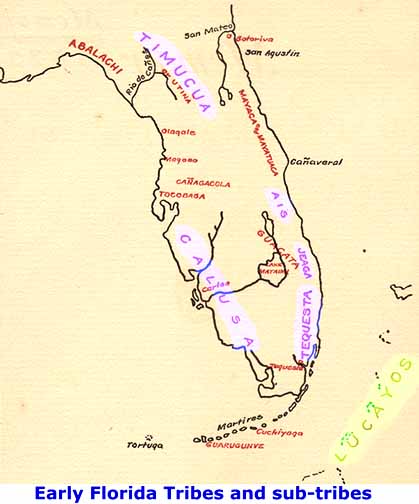-
History of Florida
-
By Jerry Wilkinson
-
-
-
(These six Florida history pages are presented as reference.
JW)
- HISTORIC FLORIDA INDIANS -
-
From the beginning, the
human race has progressed to higher and more efficient life styles. The
various Indian cultures banded together into what we now call tribes. Those
that were here when Columbus made his voyage are referred to as historic
Indians or pre-Columbian Indians. Therefore, with the arrival of the white
man and his written language, out went the prehistoric times and in came
the historic times. Fragments of written evidence, such as hand written
ship logs and guides (derroteros) began to appear.
 At the beginning of the historic period, in 1492 AD, it is conservatively
estimated that there were about 100,000 Indians living in Florida. Some
estimate as many as 350,000. Accepting the first estimate, the distribution
is thought of as this: Timucuans in the northeast, 40,000; Apalachee and
Pensacola in the northwest, 25,000; Tocobaga in the west-central, 8,000;
Calusa in the southwest, 20,000; Tequesta in the southeast, 5,000; Jeaga,
Jobe and Ais in the east-central, 2,000. There were others, as well as
sub-groups, i.e., Saturiwa, Santaluces, Boca Ratones, Tocobaga, etc. By
the late 1700s, it is thought that all of these indigenous Indians were
gone. Also, note that there is no mention of the Seminoles, as they did
not enter Florida until the early 1700s.
At the beginning of the historic period, in 1492 AD, it is conservatively
estimated that there were about 100,000 Indians living in Florida. Some
estimate as many as 350,000. Accepting the first estimate, the distribution
is thought of as this: Timucuans in the northeast, 40,000; Apalachee and
Pensacola in the northwest, 25,000; Tocobaga in the west-central, 8,000;
Calusa in the southwest, 20,000; Tequesta in the southeast, 5,000; Jeaga,
Jobe and Ais in the east-central, 2,000. There were others, as well as
sub-groups, i.e., Saturiwa, Santaluces, Boca Ratones, Tocobaga, etc. By
the late 1700s, it is thought that all of these indigenous Indians were
gone. Also, note that there is no mention of the Seminoles, as they did
not enter Florida until the early 1700s.
Please be aware that
all these Indian names, and those given later, were names given by their
so called educated new-world explorers, primarily Europeans. The presumed
names would be recorded phonetically by each writer. Even the Seminoles,
who are not indigenous Florida Indians, never did -and still do not- call
themselves Seminoles when speaking privately among themselves.
There exists considerable debate
about which historic Indians were the early inhabitants of the Keys. Historians
are relatively certain that the Florida West Coast Calusa was dominant
and exercised political control over the east coast Tequesta’s. However,
the two tribe’s pottery differs and fragments of pottery found in the Keys
often indicate presence of the Tequesta, but the living areas (middens)
were shell mounds indicating Calusa. There is also mounting evidence that
the Caribbean Island Indians may have also inhabited the Keys. The present
archaeological evidence is not conclusive, other than the general reference
by early European travelers to the Matecumbes as the Keys Indians.
Another explanation is that
the Calusa was actually a confederation of other tribes including the Tequesta,
Ais, Jeaga and others. All of these major tribes are thought to have been
composed of sub-tribes usually named after their respective chiefs, possibly
giving rise to names like Matecumbes, Bahiahondas and Biscaynos. The latter
were the names prevalently used by the early European travelers to the
Keys and the former names to those of the mainland. This compares with
a person who could be described as Irish, American, Floridian, Dade Countian
and Miamian, but there is still only one person. Ethnology deals with not
only the place of origin, but with subsequent divisions and distributions.
For a more detailed rendition
of the above period, Click HERE, then
use back arrow to return.
I recommend that the serious
Florida Keys' Indian student consult a 1991 and 1994 published books by
John Hann titled Missions to the Calusa and Florida’s First People
by Robin C. Brown. One problem that I found was when the Spanish used the
word transcribed as " Cayo or Key", how does one know if it is the Monroe
County Keys or some other Florida Key such as those on Florida’s west coast.
The only time I feel certain is when they refer to the Martyrs.
-
- - - - - - - - - - - - -
-
To tour through the other five Florida History pages, Click
HERE.
Use Back Arrow to return to reading previous page or:
To return to the General History homepage, Click
HERE.
|
At the beginning of the historic period, in 1492 AD, it is conservatively estimated that there were about 100,000 Indians living in Florida. Some estimate as many as 350,000. Accepting the first estimate, the distribution is thought of as this: Timucuans in the northeast, 40,000; Apalachee and Pensacola in the northwest, 25,000; Tocobaga in the west-central, 8,000; Calusa in the southwest, 20,000; Tequesta in the southeast, 5,000; Jeaga, Jobe and Ais in the east-central, 2,000. There were others, as well as sub-groups, i.e., Saturiwa, Santaluces, Boca Ratones, Tocobaga, etc. By the late 1700s, it is thought that all of these indigenous Indians were gone. Also, note that there is no mention of the Seminoles, as they did not enter Florida until the early 1700s.
